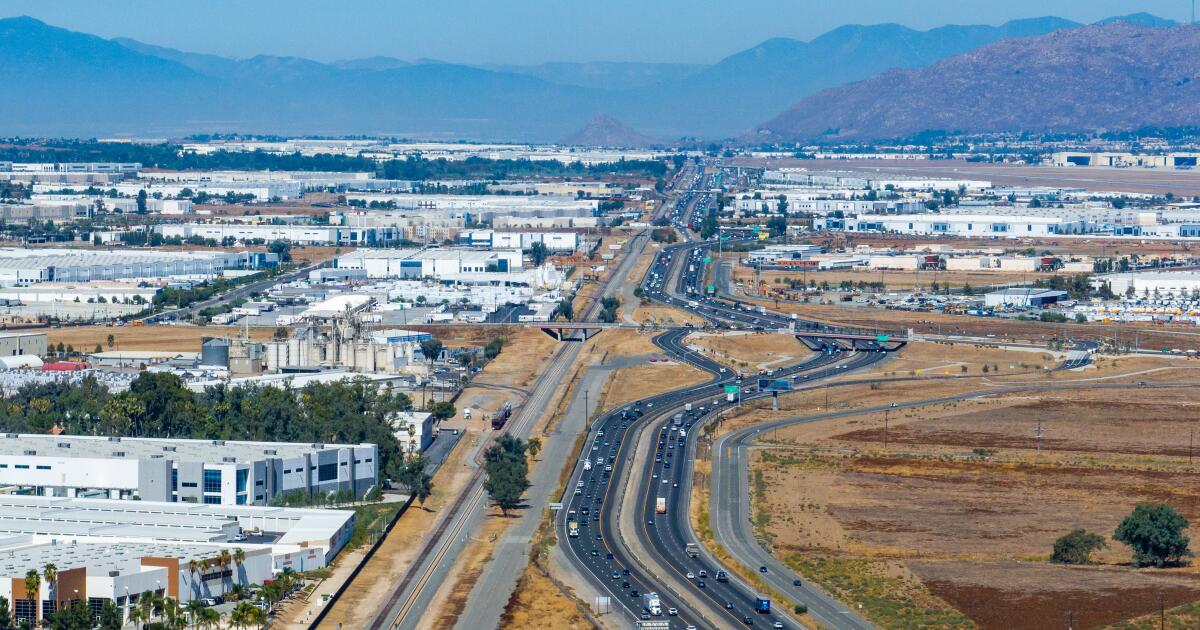Mead Valley, California – A Community Fearing the Rise of Warehouses
The Industrial-Residential Border
Seen from above, the industrial-scale warehouses straddling Interstate 215 in Mead Valley appear like a sprawling lake of white concrete boxes. In this unincorporated Riverside County community, big-box distribution hubs have long been contained to a substantial strip west of the freeway. Burlington, Living Spaces, and FedEx are among nearly 50 warehouse properties located here, capitalizing on Mead Valley’s easy access to rail and freeway corridors.
A Community Fearing the Loss of Solitude
Beyond this strip, however, Mead Valley residents embrace a rural lifestyle. People here raise horses and livestock; most streets are lined with gravel trails, rather than sidewalks, to accommodate riders on horseback. Besides the new Farmer Boys restaurant near the freeway, the community has few local businesses other than gas stations, feed stores, and plant nurseries.
As e-commerce exploded during the COVID-19 pandemic, more distribution centers rose along the freeway, bringing more trucks to local roadways. Still, there was an understanding that, beyond the clearly delineated industrial zone, Mead Valley residents could maintain their solitude and sweeping views, in exchange for shouldering a disproportionate share of an industry critical to America’s online shopping habit.
The Proposed Changes
County leaders are reviewing a dozen requests that would rezone portions of rural residential land in Mead Valley to create more space for industrial use. Developers are seeking to expand warehouse development beyond the established industrial zone; at least one proposal would result in the demolition of dozens of homes as well as dedicated open space. Others would pierce the existing boundary, bringing the potential for warehouses and their 24/7 noise and exhaust to the outskirts of existing neighborhoods, fundamentally altering residents’ lifestyles.
A Challenge for County Leaders
County Supervisor Kevin Jeffries, who represents the district that includes Mead Valley, says he has "deep concerns" about the proposed changes. He described drawing a "big red rectangle" over Mead Valley’s industrial zone, indicating where he believes the boundaries of warehouse development should remain.
"It’s going to be a challenge if they cross that line and start marching into what you might call Mead Valley proper," Jeffries said. "You start moving up that way — when or where does it stop?"
The Battle for Mead Valley’s Future
Resident Karla Cervantes expressed similar concerns. Cervantes and her husband, Franco Pacheco, raise their children and sheep on two acres in Mead Valley. She worries neighborhoods will start falling like dominoes as more rural residential land is rezoned for industrial use.
"Once one neighborhood is surrounded by warehouses, then the investors will come, buy them out, and then it creeps up more and more and more," Cervantes said.
The County’s Rezoning Process
Riverside County’s unique rezoning process is the result of a more than two-decade-old settlement with the conservation group Endangered Habitats League, which sued the county in 2003 over concerns about sprawling development. The settlement "resulted in a way to slow-roll development in the rural areas of the county," said county planning director John Hildebrand.
Under terms of the settlement, developers who want to request zoning changes for swaths of land from one of five major uses to another — agriculture, open space, rural, rural community, or community development — are able to request that change only every eight years, during the county’s Foundation General Plan Amendment cycle.
The Mead Valley Coalition for Clean Air
Pacheco and Cervantes have launched the Mead Valley Coalition for Clean Air to oppose warehouse expansion. They see the rezoning fight as a fight for Mead Valley’s future. For the residents who stay, the question is whether county leaders will rubber-stamp continued expansion of the I-215 industrial corridor, and whether that line in the dirt — between industrial and rural residential — will survive.
Conclusion
Mead Valley, a majority Latino community of about 20,500 people, already has 2,000 square feet of warehouses per person, including existing and approved warehouses and those under environmental review. That’s one of the highest warehouse-per-resident ratios in the Inland Empire, according to their analysis. And the rezoning applications that developers have submitted would add more than 1,000 additional acres of warehouse projects.
As the county reviews the proposed changes, the Mead Valley community is left to wonder: will they be able to preserve their way of life, or will the warehousing phenomenon transform their rural community into a sea of concrete and steel?
FAQs
Q: What is the proposed change in Mead Valley?
A: The county is reviewing a dozen requests to rezone portions of rural residential land in Mead Valley for industrial use.
Q: What are the concerns of Mead Valley residents?
A: Residents worry that the proposed changes will bring noise, pollution, and decreased property values to their community, as well as the potential loss of their rural lifestyle.
Q: What is the county’s role in the rezoning process?
A: The county is responsible for reviewing the proposals and deciding whether to approve or deny them. The county’s unique rezoning process, established as part of a settlement with the Endangered Habitats League, allows for only one rezoning application every eight years.
Q: What is the Mead Valley Coalition for Clean Air doing to oppose warehouse expansion?
A: The coalition, founded by Karla Cervantes and her husband, Franco Pacheco, is fighting to preserve Mead Valley’s rural character and opposing warehouse development.


